China, empire of living symbolsby Lindqvist, Cecilia
Publication date 1991Topics Chinese characters, China -- CivilizationPublisher Reading, Mass. : Addison-WesleyCollection inlibrary; printdisabled; internetarchivebooksContributor Internet ArchiveLanguage English
423 p. : 23 cm
Chinese characters on added t.p.: Han tzu yüan liu
Translation of: Tecknens rike
"A Merloyd Lawrence book."
Includes bibliographical references (p. 411-416) and index
Notes
Cut-off on map text inherent from the source.


 See all 2 images
See all 2 imagesCecilia Lindqvist
Follow
China: Empire of Living Symbols Hardcover – 18 October 1991
by Cecilia Lindqvist (Author)
4.7 4.7 out of 5 stars 60 ratings
424 pages
Language

Chinese Characters: Their Origin, Etymology, History, Classification and Signfication. a Thorough Study from Chinese Documents
L. WIEGER
3.9 out of 5 stars 42
Paperback
$47.78$47.78
Get it 30 Aug - Sep 5FREE Shipping
Only 3 left in stock.
Customer reviews
4.7 out of 5 stars
4.7 out of 5
60 global ratings
5 star 77%
4 star 14%
3 star 6%
2 star 2%
1 star 0% (0%)
0%
How are ratings calculated?
Review this product
Share your thoughts with other customers
Write a customer review
Sponsored
Top reviews
Top reviews from Australia
There are 0 reviews and 0 ratings from Australia
Top reviews from other countries
Translate all reviews to English
Clara
4.0 out of 5 stars A beatiful book in a good conditionReviewed in Canada on 22 April 2022
Verified Purchase
The book we got was pretty nicely packed and in a good condition. Thanks.
Report
Hosang Yu
5.0 out of 5 stars It is very important tool to make it easy to remember Chinese charactersReviewed in the United States on 19 January 2015
Verified Purchase
So fascinating as the title implies.
It affectionately describes many important Chinese characters.
It is very important tool to make it easy to remember Chinese characters. Learning Chinese without knowing it is like you learn English without realizing elements of 're' + 'turn' is actually has its own meaning.
Moreover, learning it sometimes feels like decoding the history and culture of China.
But unfortunately, many institutions neglect this.
I have a close friend who teaches Hanzi(Chinese character) in Korean high school and asked why we(me and students these days) can't learn in this way and she confessed to me about practical reasons. i.e. Chinese language needs higher status in international scenes to get more resources in terms of time and money. And you can imagine that even if Chinese language gains this status, simplified Chinese already lost much attraction of this symbolic beauty. So opportunity for this 'character' (not language itself) to get importance is very far away.
Even in China, the birth place of this amazing character system, the best method to learn their characters is 读, 写, 背: Read, Write, and Memorize, according to my friend who teaches Chinese to the students in elementary school in China. And she also admitted that the symbolism of the character is much neglected except very simple ones such as 山(mountain) or 水(water)...
Too sad if you know learning this is so exciting, making learning Chinese even easier: Two major difficulties in learning Chinese as non native tongue are intonation and character.
Don't be worried about traditional or simplified when you learn Chinese in traditional character, because processing and transform from traditional to simplified Chinese in your brain is not a big deal -but reverse is difficult: Think how many Taiwanese people can read simplified Chinese and their counterpart in the 'mainland' can read the other.
Read less
2 people found this helpfulReport
Susanne
5.0 out of 5 stars Genial!Reviewed in Germany on 22 May 2014
Verified Purchase
Ein äußerst interessantes und reichlich bebildertes Buch für jene, die sich nicht nur für die chinesische Schrift bzw. Sprache, sondern sich auch für die chinesische Kultur mit all ihrem Traditions- und Facettenreichtum interessieren!
Warum sehen die chinesischen Schriftzeichen so aus, wie sie aussehen? Und warum sind sie häufig so schwierig zu entschlüsseln oder einzuprägen? Die chinesische Schrift entstand aus Bildern bzw. Zeichnungen; dabei handelte es sich nicht um Skizzen oder grobe Symbole, sondern ausgeklügelte Zeichnungen mit Liebe zum Detail! Ein typisches Beispiel ist das Zeichen für "Frau", das aus einer Abbildung eines gewickelten Kimonos entstanden ist. So kann man sich die chinesische Schrift in der Tat einprägen!
Die Autorin greift die Hintergründe zu allen Schriftzeichen auf und beschreibt mithilfe zahlreicher Illustrationen und Fotos, wie die einzelnen Schriftzeichen entstanden sind.
Die Kapitel sind nach Lebensbereiche bzw. Themen sortiert und stellen die wichtigsten Schriftzeichen vor. Mao tse Tung liess seinerzeit die Schrift reformieren und vereinfachen, um auf diese Weise mehr Leute zu alphabetisieren. Deshalb erscheinen in diesem Buch zum Teil auch frühere Schriftzeichen, die komplexer sind, aber auch noch näher an den rusprünglichen Illustrationen und Bedeutungen der Wörter sind.
Ergo ein klasse Buch - ob man es als Informationsquelle über die chinesische Kultur oder als Ergänzung zum Sprachunterricht verwendet.
Read more
2 people found this helpfulReport
Translate review to English
Laerte Agnelli
5.0 out of 5 stars study china and love chinese languageReviewed in the United States on 8 January 2009
Verified Purchase
The author Cecilia Lindquist has sent my best New Year gift: her book really is a fascinating introdution to Chinese world ! By explaining the relation of characters to the dynamics of the Nature, she demonstrates in an iluminated way - using ideograms and photos - all the traditional characteristics of China`s millenar culture. This - and only this - is the book I was dreaming of, to study chinese language. A book that comes from the origin to the present day using the precious characters. And, as a matter of fact, this - in my way of thinking - is the best way to a foreigner memorise those fantastic, logic and creative symbols! As for not having the pinyin -( pronunciation )- I take this as a way that the author discovered to create a book that is at the same time pleasant to read and a workbook, to learn, for I have already started to write at the the side of each ideogram its pronunciation! Terrific to really memorise them!Congratulations to Amazon that once more contributes to those that are thirsty of languages knowledge. If you, like me, really want to know the chinese fabulous language, don`t miss this book.
4 people found this helpfulReport
Andy Du
5.0 out of 5 stars Good quality & Shipped FastReviewed in the United States on 23 October 2020
Verified Purchase
It was like a new book without any wear and tear mark at all. It was shipped quickly even without Prime membership.
Report
See more reviews

 See this image
See this imageFollow the Author

Cecilia Lindqvist
Follow
Empire of Written Symbols: The Empire of the Written Symbol Hardcover – 19 March 1992
by Cecilia Lindqvist (Author)
5.0 5.0 out of 5 stars 3 ratings
The pictorial origins and history of Chinese script are here described by a scholar who uses language that is comprehensible to the general reader. Drawing on archaeology, paleographic research and evidence of 20th century Chinese art and culture, this book offers a picture of how mental associations are formed by visual images and symbols. Among the characters discussed are those featuring the human body, wild and domestic animals, chariots and boats, tools and weapons, even musical instruments. This book is designed to appeal to those interested in Chinese script and Chinese art and history.
Report incorrect product information.
Print length
424 pages
ASIN : 0002721619
Publisher : HarperCollins (19 March 1992)
Language : English
Hardcover : 424 pages
ISBN-10 : 9780002721615
ISBN-13 : 978-0002721615
Dimensions : 21.4 x 2.95 x 20.6 cmCustomer Reviews:
5.0 5.0 out of 5 stars 3 ratings
About the author
Follow authors to get new release updates, plus improved recommendations.
Top reviews from other countries
Cai.
5.0 out of 5 stars This book is very impressive by revealing how ancient Chinese ...Reviewed in the United States on 3 March 2017
Verified Purchase
This book is very impressive by revealing how ancient Chinese people invented Chinese Characters to address something or express themselves.
Report
Bex
5.0 out of 5 stars WonderfulReviewed in the United Kingdom on 30 June 2013
Verified Purchase
A truly fascinating insight into Chinese culture & the development of many Chinese characters. I find that understanding characters' origins helps me remember the characters better. Beautifully illustrated too.
Report
See more reviews
한자왕국
세실리아 링크비스트 (지은이),하영삼,김하림 (옮긴이)청년사2002-07-30원제 : Tecknens Rike
이전
다음
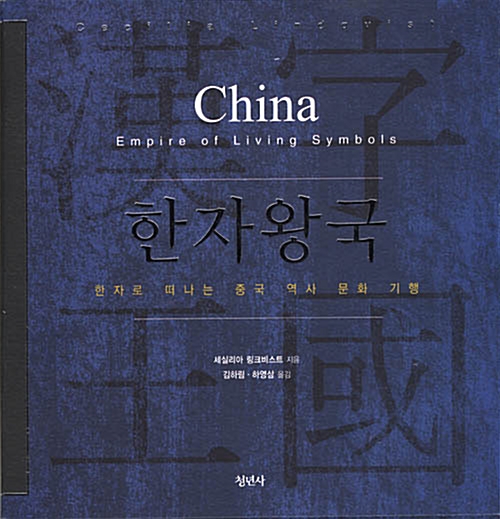



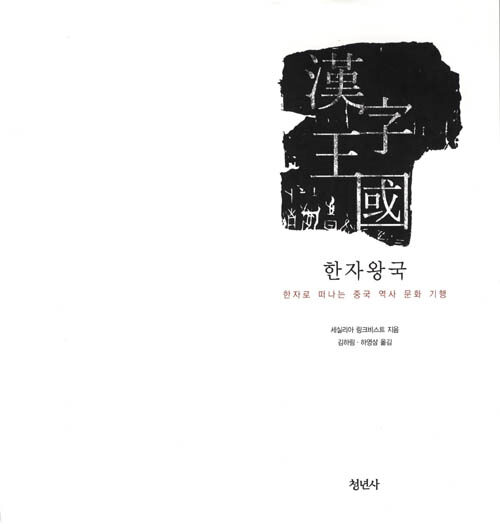


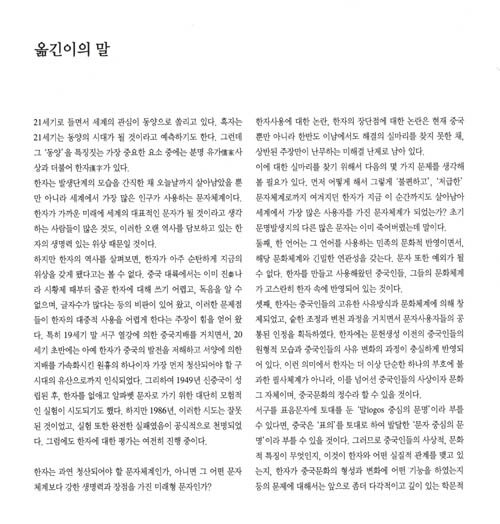
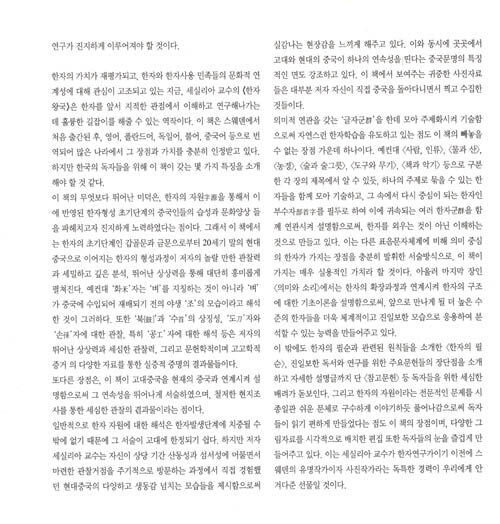




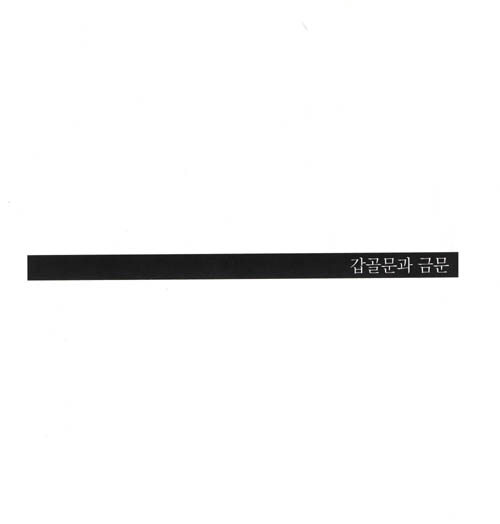

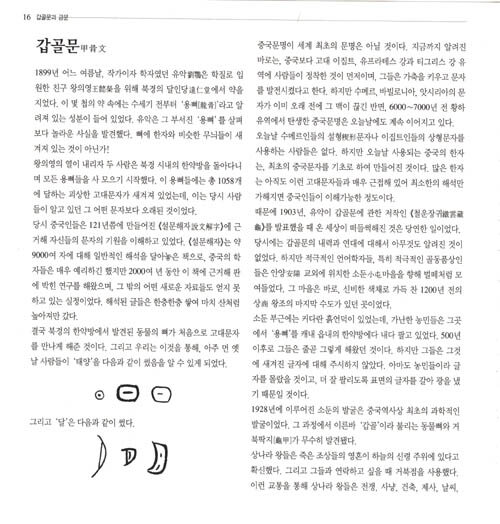

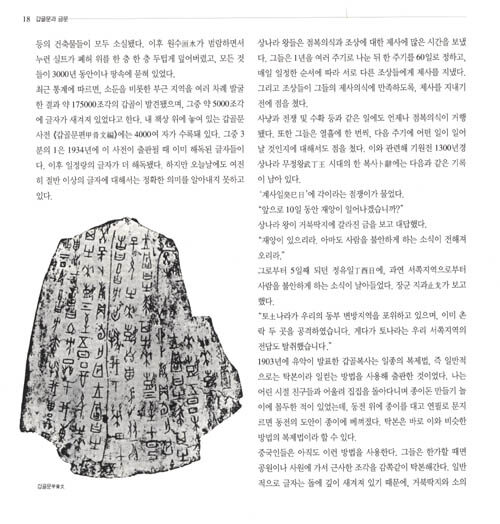


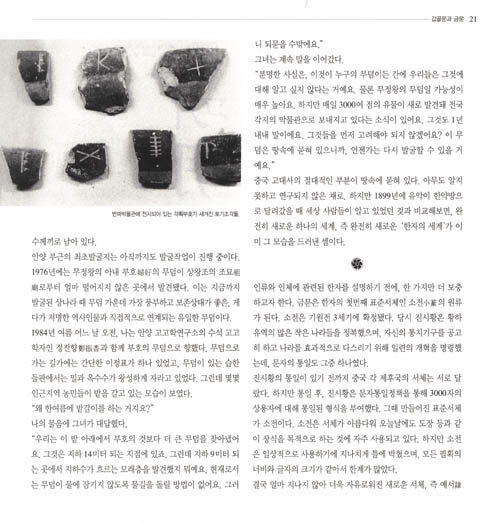

보온보냉 런치박스.만화지 노트.형광펜(자격증.토익.공무원.IT교재 4만원 이상)
정가
18,000원
판매가
16,200원 (10%, 1,800원 할인)
마일리지
900원(5%) + 486원(멤버십 3%)
+ 5만원이상 구매시 2,000원

배송료
무료
Sales Point : 677

이 책 어때요?
카드/간편결제 할인

무이자 할부

소득공제 730원

절판 판권 소멸 등으로 더 이상 제작, 유통 계획이 없습니다.
절판
보관함 +
- 절판 확인일 : 2017-03-08

알라딘 리뷰
"한자에 숨어있는 중국의 역사와 문화를 밝힌다"
지금까지도 국한문 혼용에 대한 논란이 계속될만큼, 외우기 어렵고 복잡하게만 느껴지는 한자. 하지만 한자는 지금까지도 사용되고 있는 최고最古의 언어이며, 또한 가장 많은 사용자를 갖고 있는 언어이다. 이 책은 이러한 한자야말로 중국 문화를 이해하는 키워드라고 이야기하며, 한자의 근원을 밝힘과 동시에 그와 관련된 중국의 역사와 문화를 차분하게 소개하고 있다.
스웨덴 출신의 저자는 중국에 대한 해박한 지식을 바탕으로 한자가 형성 초기부터 지금에 이르기까지 중국인들의 습성과 문화양상에 어떠한 영향을 받았는지를 진지하게 파헤친다. 이를테면 '깃털 우羽'를 설명하면서 경극의 배우들을 장식하는 깃털이 어떤 의미를 전달하는지를 알려주는 부분이나, '손자 손孫'를 설명하면서 타이완에서 봤던 장례행렬을 연결지어 이야기하는 등의 내용은 저자의 세심한 관찰력과 대담한 상상력을 돋보이게 한다.
한자에 관련된 책들이 '펜글씨 교본'이나 '완성1주일'류가 태반을 이뤘던 것과 달리, 이 책은 굳이 한자를 강요하지 않으면서도 한자의 기원과 그 바탕이 되는 중국 문화를 자연스럽게 익힐 수 있다는 강점을 가지고 있다. 또한 이를 돕기 위해 저자는 수많은 도판과 함께 갑골문과 금문에서 찾아낸 한자의 원형을 그림으로 수록하는 등의 수고를 아끼지 않았다.
중국 문화를 알기 위해선 필수적인 한자를 알기 쉽고도 입체적으로 설명한 이 책은 한자라면 머리가 아프다는 학생들이나, 뒤늦게 한자를 익히려는 이들의 흥미를 돋구는 데 충분할 듯 하다. - 조선영(2002-08-20)
목차
머리말
옮긴이의 말
갑골문과 금문
사람, 인류
물과 산
야생 동물
가축
수레, 길, 그리고 배
농경
술과 술그릇
삼과 비단
대와 나무
도구와 무기
지붕과 가옥
책과 악기
숫자와 추상글자
의미와 소리
한자왕국
한자의 필순
참고문헌
중국 역대왕조와 사기
찾아보기
접기
저자 및 역자소개
세실리아 링크비스트 (Cecilia Lindqvist) (지은이)
저자파일
신간알리미 신청
스웨덴의 작가이며 중국 문제 전문가. 지은 책으로는 <아롱과의 여행>, 스완 링크비스트와 공동집필한 <내부에서 본 중국>, <아시아의 경험>, <모택동은 무엇을 말했을까?> 등이 있다.
최근작 : <한자왕국> … 총 5종 (모두보기)
하영삼 (옮긴이)
저자파일
신간알리미 신청
경남 의령 출생으로, 경성대학교 중국학과 교수, 한국한자연구소 소장, 인문한국플러스(HK+)사업단 단장, 세계한자학회(WACCS) 상임이사로 있다. 부산대학교 중문과를 졸업하고, 대만 정치대학에서 석?박사 학위를 취득했으며, 한자에 반영된 문화 특징을 연구하고 있다.
저서에 <한자어원사전>, <100개 한자로 읽는 중국문화>, <한자와 에크리튀르>, <부수한자>, <뿌리한자>, <연상한자>, <한자의 세계: 기원에서 미래까지>, <제오유의정리와연... 더보기
최근작 : <키워드 한자 : 24개 한자로 읽는 동양문화 - 하>,<키워드 한자 : 24개 한자로 읽는 동양문화 - 상>,<韓國近代漢字字典硏究> … 총 61종 (모두보기)
김하림 (옮긴이)
저자파일
신간알리미 신청
고려대학교 중어중문학과에서 『魯迅 문학사상의 형성과 전변 연구』로 박사학위를 받았고, 현재 조선대학교 중국어문화학과에 재직 중이다. 지은 책으로는 『루쉰의 문학과 사상』(공저, 1990), 『중국 문화대혁명시기 학문과 예술』(공저, 2007) 등이 있고, 옮긴 책으로는 『중국인도 다시 읽는 중국사람 이야기』(1998), 『한자왕국』(공역, 2002), 『중국의 차문화』(공역, 2004), 『차가운 밤』(2010) 등이 있다.
최근작 : <한 손에 잡히는 중국> … 총 18종 (모두보기)
등록
마이페이퍼 > 마이페이퍼
글 작성 유의사항
구매자 (1)
전체 (2)
공감순

강추 소장!!
우왕 2014-11-16 공감 (0) 댓글 (0)
Thanks to
공감
마이리뷰
구매자 (1)
전체 (1)
리뷰쓰기
공감순

Living Symbols
영어제목을 보면 'Empire of Living Symbols'라고 되어 있습니다. 책을 읽고나면 느끼시겠지만 '한자왕국'이라기 보다는 영어제목이 더 어울린다는 생각이 드네요. 어떻게 번역을 해야 하는지는 저도 잘 모르겠지만 말입니다.
문화적인 편견을 가지고 있는지 몰라도, 중국의 한자에 대해서 이렇게 풍성하게 책한권을 써 놓은 사람이 스웨덴 사람이란 것을 알게 되면 대체 어떤 사람이었을까 하는 호기심마저 생깁니다.
이 책은 우리가 알고 있는 한자 중 기본적인 것들을 뽑아서 관련된 풍성한 자료를 보여줍니다. 기본글자가 선택이 된것은 바로 그 기본글자들이 진정한 '상징'이기 때문일 것입니다. 우리나라 학교교육을 얌전히 받은 사람들이라면 어렵지 않게 읽을 수 있는 한자들로 구성되어 있어서 '한자'에 대한 공포감은 없이 읽을 수 있게 되어 있습니다.
이 책의 장점이자 풍성함이란 우리가 알고 있는 단순한 글자에 불과한 '한자'를 살아있는 문화이자 역사의 상징으로 바꿔볼 수 있는 시각을 제공해 주는 것입니다. 대부분의 사람들은 '人'자가 사람 모양을 본떠서 만들었다는 얘기는 들었을지 몰라도 '人'자로 부터 파생되는 다른 것들은 알지 못했을 것입니다. 저또한 몰랐으니까요.
또한, 각 글자를 개별적으로 나열식으로 설명하고 끝내는 식이 아니라 관계가 있는 것들을 묶어서 더욱 풍성한 읽을거리를 제공해 줍니다. 예를 들어 '야생동물', '지붕과 가옥'등입니다. 이 책은 '한자교본'이 아닙니다. 고대에 만들어져서 현재도 사용하고 있는 한자에 깃들어있는 중국의 문화와 역사를 느끼도록 인도해 주는 안내서라고 하는 것이 더 어울릴 것입니다.
마지막으로 저자에게 더욱 감탄하는 점은 갑골문이나 금문의 그림문자를 어떻게 특정 한자로 연결시킬 수 있는지 그 상상력 만큼은 도저히 이해하기 힘이 듭니다. 제가 보기엔 엇비슷해 보이는 그림들인데 말입니다.
- 접기
Crafter 2002-10-24 공감(0) 댓글(0)
Thanks to
공감
Cecilia Lindqvist
Cecilia Lindqvist | |
|---|---|
 | |
| Born | Cecilia Norman 4 June 1932 |
| Died | 27 September 2021 (aged 89) |
| Nationality | Swedish |
| Other names | 林西莉 (Lin Xili) |
| Occupation(s) | Sinologist, professor, author |
| Spouse | (m. 1956; div. 1986) |
| Awards | August Prize |
Cecilia Lindqvist (Chinese name: Lin Xili 林西莉; 4 June 1932 – 28 September 2021) was a Swedish Sinologist. She was a professor and author of several books on China.
Biography[edit]
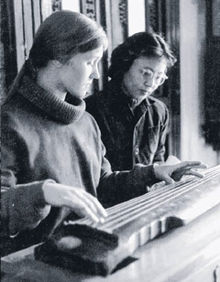
Cecilia Norman was born in Lund in 1932. She was interested in China because it had such a long history. She first visited the country when she was 28 with letters of recommendation including one from the King of Sweden. She went to see all the porcelain and paintings she had read about and to study the country. She also learnt to play the stringed instrument called the guqin. She ate the same diet as her hosts which was low in protein. Lindvqist became ill and she lost her hair but continued to study.[1]
She was married to Sven Lindqvist from 1956 to 1986. They wrote books on China together that were published in 1964, 1979 and 1980.
In 1970 she was working as a teacher when they asked if anyone could teach Chinese. Lindqvist rose to the challenge and taught 18 students successfully for the first year. in 1974 she started to write the book Kingdom of Characters which was not complete until 1989. She won the August Prize for that book and she is one of the few authors to have been given that award twice.[1]
In 1991 she wrote a book entitled China: Empire of Living Symbols which traces how Chinese characters used today can be traced back to Stone Age markings made on bone.[2]
Her 2006 book entitled Qin is about the seven-stringed zither that Lindqvist had first seen in China in 1961.[3] She died on 27 September 2021.[4]
Works[edit]
- China from the Inside (with Sven Lindqvist ) (1963)
- Asian Experience (with Sven Lindqvist) (1964)
- Traveling with Aaron (1969)
- What Would Mao Say? (with Sven Lindqvist) (1979)
- China (with Sven Lindqvist) (1980)
- Characters Kingdom (Bonnier, 1989). ISBN 91-34-50857-0
- China: Empire of Living Symbols (1991)
- Qin (Albert Bonnier, 2006). ISBN 91-0-010580-5
References[edit]
- ^ a b "Cecilia Lindqvist, "ambassador" of Chinese culture". Peoples Daily Online. Retrieved 20 October 2012.
- ^ China: Empire of Living Symbols, Amazon.com
- ^ Qin, Cecilia Linds, A translation of the table of contents, accessed October 2012
- ^ "Sinologen och författaren Cecilia Lindqvist är död – blev 89 år" (in Swedish). Dagens Nyheter. Retrieved 29 September 2021.
